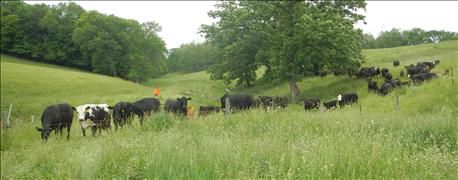May 4, 2016

Most beef cattle producers understand the importance of providing high-quality nutritional feedstuffs to achieve herd-specific goals of better production or herd health. The bottom line of production will always be the bottom line.
Anyone in business is willing to cut costs if it means producing the same high quality product with an increased profit margin. As for beef producers, what is one nutritional item that should not be neglected in the diet if margins are tight? Salt.

Salt is a vital nutritional component which should not be overlooked when it comes to your beef cattle.
Salt is the combination of two separate chemical ions—sodium and chloride. Both sodium and chloride are important to maintain important metabolic cellular functions in the body. They help maintain volume, pH and osmolarity of body fluids. These three functions are what cells use to transport nutrients across their cell walls.
Sodium is also responsible for helping transmit nerve impulses which control all three different types of muscles—skeletal, smooth (found in the gastrointestinal tract) and cardiac. It is also found in saliva which aids ruminal fermentation by acting as a buffer.
Chloride is a fundamental mineral for production of hydrochloric acid in the abomasum. When consumed as salt (sodium chloride), it is absorbed in the digestive tract with 100% efficiency.
According to the National Academy of Science Nutritional Requirements of Beef Cattle, requirements for this mineral have not been established. However, chloride deficiency does exist, and signs such as weight loss, reduced dry matter intake and eye defects may develop.
This product which is ubiquitous at every dinner table, should be the same nutrient which is ubiquitous on every beef operation. Salt is the common product used to deliver the requirement of sodium and chloride. Sodium is one of a few minerals which cattle use efficiently. However, they do not maintain any reserves, and sodium deficiency may develop quickly if access is limited.
Cattle are “nutritionally sensible” when it comes to the consumption of salt. They inherently know when they need to consume salt and may substitute their craving for salt with other items they would not normally consume. This substitution is scientifically called pica. hey may lick soil and chew on objects such as fence posts to appease their need for salt. In addition to this odd behavior, cattle may also develop muscle or nervous system signs if severely deficient in sodium.
Several different feeding methods for salt exist. Which should you choose—block or free-choice? With trace minerals added or salt only?
The option you choose is farm operation dependent as a one–size-fits-all solution does not exist. Nutritionists have differing opinions on the best way to supplement rations for beef cattle when it comes to salt. I would advise you work with your nutritionist to develop a strategy which best suits your farm operation.
Salt is a vital nutritional component which should not be overlooked when it comes to your beef cattle. As we look at the beef market futures, one may be tempted to cut costs. However, do not cut the expense of salt in your herd’s diet.
Salt may be a matter of small stuff, but it is the small stuff that matters.
Mills-Lloyd, is a DVM and she is the Oconto County agriculture Extension agent specializing in dairy and livestock.
You May Also Like




